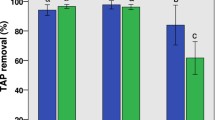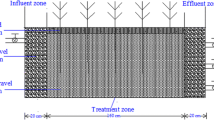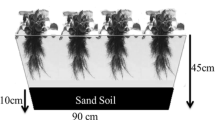Abstract
The sorption and bioconcentration of Hg, Se, and As were measured in Schoenoplectus californicus and Typha angustifolia in a pilot constructed wetland receiving wastewater inflows containing these elements at potentially hazardous levels. Results indicated that these species bioconcentrated Hg, Se, and As at factors of up to 1,911, 10,981, and 4,927, respectively. Plant tissue concentrations decreased as Hg, Se, and As were translocated from the roots to the aerial portions of the plant. Greatest element concentrations in S. californicus were found in roots, indicating that an exclusion mechanism may be responsible for element tolerance by this plant species. Greater root:shoot transfer of Hg, Se, and As was observed with T. angustifolia than with S. californicus, suggesting that element tolerance was more likely due to an internal detoxification mechanism. To completely assess ecological risks associated with the use of constructed wetlands, contaminant bioavailability for plant uptake, translocation, and bioconcentration must be considered.







Similar content being viewed by others
References
Ansede, J. H., Pellechia, P. J., & Yoch, D. C. (1999). Selenium biotransformation by the salt marsh cordgrass Spartina alterniflora: Evidence for dimethylselenoniopropionate formation. Environmental Science and Technology, 33, 2064–2069.
Beath, O. A., Eppsom, H. F., & Gilbert, C. S. (1937). Selenium distribution in and seasonal variation of vegetation type occurring on seleniferous soils. Journal of American Pharmacology Association, 26, 394–405.
Black, W. C. (1986). Methods of soil analysis part 1 (2nd ed.). Wisconsin: American Society of Agronomy.
Brix, H. (1997). Do macrophytes play a role in constructed treatment wetlands? Water Science and Technology, 35(5), 11–17.
Burton, G. A. (1991). Assessing the toxicity of freshwater sediments. Environmental Toxicology and Chemistry, 10, 1585–1627.
Cardwell, A. J., Hawker, D. W., & Greenway, M. (2002). Metal accumulation in aquatic macrophytes from southeast Queensland, Australia. Chemosphere, 48, 653–663.
Compton, A., Faust, R. D., & Salt, D. (2001). Arsenic accumulation in Potomogeton ellinoiensis in Montezuma Well, Arizona. Meeting of the American Chemical Society Abstracts, 221(1–2), ENR22.
Crist, R. H., Martin, J. R., & Crist, D. R. (1991). Interactions of metals and protons with algae. Equilibrium constants and ionic mechanisms for heavy metal removal as sulfides and hydroxides. In R. W. Smith & M. Misra (Eds.), Mineral bioprocessing (pp. 275–287). Warrendale, PA: TMS.
de Souza, M. P., Huang, C. P. A., Chee, N., & Terry, N. (1999). Rhizosphere bacteria enhance the accumulation of selenium and mercury in wetland plants. Planta, 209(2), 259–263.
Electric Power Research Institute (EPRI) (1999). Flue gas desulfurization by-products: Composition, storage, use, and health and environmental information. An issue report from EPRI. Available at http://www.epri.com.
Ellington, J. J., & Evans, J. J. (2000). Determination of perchorate at parts-per-billion levels in plants by ion chromatography. Journal of Chromatography A, 898, 193–199.
Estabrook, G. F., Burk, D. W., Inman, D. R., Kaufman, P. B., Wells, J. R., & Jones, J. D. et al. (1985). Comparison of heavy metals in aquatic plants on Charity Island, Saginaw Bay, Lake Huron, U.S.A., with plants along the shoreline of Saginaw Bay. American Journal of Botany, 72(2), 209–216.
Faulkner, S. P., Patrick, W. H., & Gambrell, R. P. (1989). Field techniques for measuring wetland soil parameters. Soil Science Society of America Journal, 53, 883–890.
Filgueiras, A. V., Lavilla, I., & Bendicho, C. (2002). Chemical sequential extraction for metal partitioning in environmental samples. Journal of Environmental Monitoring, 4, 823–857.
Gee, G. W., & Bauder, J. W. (1986). Particle-size analysis. In Methods of soil analysis part 1 (2nd ed., pp. 383–410). Wisconsin: American Society of Agronomy.
Giblin, A. E., Bourg, A., Valiela, I., & Teal, J. M. (1980). Uptake and losses of heavy metals in sewage sludge by a New England salt marsh. American Journal of Botany, 67(7), 1059–1068.
Gleyzes, C., Tellier, S., & Astruc, M. (2002). Fractionation studies of trace elements in contaminated soils and sediments: A review of sequential extraction procedures. Trends in Analytical Chemistry, 21(6), 451–467.
Guthrie, R. K., & Cherry, D. S. (1979). Trophic level accumulation of heavy metals in a cool ash basin drainage system. Water Research Bulletin, 15, 244–248.
Heller, A. A., & Weber, J. H. (1998). Seasonal study of speciation of mercury (II) and monomethylmercury in Spartina alterniflora from the Great Bay Estuary, NH. Science of the Total Environment, 221, 181–188.
Kupper, H., Zhao, F. J., & McGrath, S. P. (1999). Cellular compartmentation of zinc in leaves of the hyperaccumulator Thlaspi caerulescens. Plant Physiology, 119, 305–311.
Lacher, C., & Smith, R. (2002). Sorption of Hg(II) by Potamogeton natans dead biomass. Mineral Engineering, 15, 187–191.
Lindberg, E., & Harriss, C. (1974). Mercury enrichment in estuarine plant detritus. Marine Pollution Bulletin, 5, 93–95.
Moshiri, G. A. (Ed.). (1993). Construction wetlands for water quality improvement. Michigan: Lewis.
Murray-Gulde, C. L., Huddleson, G. M., Garber, K. V., & Rodgers, J. H. (2005). Contributions of Schoenoplectus californicus in a constructed wetland system receiving copper contaminated wastewater. Water, Air, and Soil Pollution, 163, 355–378.
Nelson, D. W., & Sommers, L. E. (1996). Organic matter. In Methods of soil analysis part 3 (p. 1004). Wisconsin: Soil Science Society of America.
Newman, M. C. (1998). Fundamentals of ecotoxicology. Michigan: Ann Arbor Press.
Outridge, P. M., & Noller, B. N. (1991). Accumulation of toxic trace elements by freshwater vascular plants. In Reveiws of environmental contamination and toxicology. New York: Springer.
Plumb Jr., R. H. (1981). Procedures for handling and chemical analysis of sediment and water samples. Technical Report. EPA/CE-18-1.
Qian, J. H., Zayed, A., Zhu, Y. L., Yu, M., & Terry, N. (1999). Phytoaccumulation of trace elements by wetland plants: III. Uptake and accumulation of ten trace elements by twelve plant species. Journal of Environmental Quality, 28, 1448–1455.
Reay, P. F. (1972). The accumulation of arsenic from arsenic-rich natural waters by aquatic plants. Journal of Applied Ecology, 9, 557–565.
Schneider, I. A. H., & Rubio, J. (1999). Sorption of heavy metal ions by the nonliving biomass of freshwater macrophytes. Environmental Science and Technology, 33, 2213–2217.
Schneider, I. A. H., Rubio, J., & Smith, R. W. (2001). Biosorption of metals onto plant biomass: exchange adsorption or surface precipitation? International Journal of Mineral Processing, 62, 111–120.
Schneider, I. A. H., Smith, R. W., & Rubio, J. (1999). Effect of some mining chemicals on biosorption of Cu(II) by the non living biomass of the freshwater macrophyte Potomogenten lucens. Mineral Engineering, 12, 255–260.
Shardendu, Salhani, N., Boulyga, S. F., & Stengel, E. (2003). Phytoremediation of selenium by two helophyte species in subsurface flow constructed wetland. Chemosphere, 50, 967–973.
Spallholz, J. E., & Hoffman, D. J. (2002). Selenium toxicity: Cause and effect in aquatic birds. Aquatic Toxicology, 57, 27–37.
Sundberg, S. E. (2006). Partitioning and toxicity of mercury, selenium, and arsenic in a constructed wetland for flue gas desulfurization wastewater treatment. Dissertation, Clemson University.
Sundberg, S. E., Hassan, S. M., & Rodgers Jr., J. H. (2006). Enrichment of elements in destritus from a constructed wetland and consequent toxicity to Hyalella azteca. Ecotoxicology and Environmental Safety, 64, 264–272.
Tessier, A., Campbell, P. G. C., & Bisson, M. (1979). Sequential extraction procedure for the speciation of particulate trace metals. Analytical Chemistry, 51(7), 844–851.
US Environmental Protection Agency (USEPA) (1994). EPA Method 200.8, Determination of trace elements in water and wastes by inductively coupled plasma-mass spectrometry, Revision 5.4, methods for the determination of metals in environmental samples. Supplement 1, EPA/600/R-94-111.
US Environmental Protection Agency (USEPA) (2000). Introduction to Phytoremediation. EPA/600/R-99/107.
Weis, J. S., & Weis, P. (2004). Metal uptake, transport, and release by wetland plants: Implications for phytoremediation and restoration. Environment International, 30, 685–700.
Weis, P., Windham, L., Burke, D. J., & Weis, J. S. (2002). Release into the environment of metals by two vascular salt marsh plants. Marine Environmental Research, 54, 325–329.
Windham, L., Weis, J. S., & Weis, P. (2004). Metal dynamics of plant litter of Spartina alterniflora and Phragmites australis in metal-contaminated salt marshes. Part 1: Patterns of decomposition and metal uptake. Environmental Toxicology and Chemistry, 23(6), 1520–1528.
Wu, L. (2004). Review of 15 years of research on ecotoxicology and remediation of land contaminated by agricultural drainage sediment rich in selenium. Ecotoxicology and Environmental Safety, 57(3), 257–269.
Wu, L., & Guo, X. (2002). Selenium accumulation in submerged aquatic macrophytes Potamogeton pectinatus L. and Ruppia maritima L. from water with elevated chloride and sulfate salinity. Ecotoxicology and Environmental Safety, 51, 22–27.
Zawislanski, P. T., Chau, S., Mountford, H., Wong, H. C., & Sears, T. C. (2001). Accumulation of selenium and trace metals on plant litter in a tidal marsh. Estuary and Coastal Shelf Science, 52, 589–603.
Author information
Authors and Affiliations
Corresponding author
Additional information
Disclaimer
The research described in this dissertation has been funded in part by the United States Environmental Protection Agency (EPA) under the Greater Research Opportunities (GRO) Graduate Program. EPA has not officially endorsed this publication and the views expressed herein may not reflect the views of the EPA.
Rights and permissions
About this article
Cite this article
Sundberg-Jones, S.E., Hassan, S.M. Macrophyte Sorption and Bioconcentration of Elements in a Pilot Constructed Wetland for Flue Gas Desulfurization Wastewater Treatment. Water Air Soil Pollut 183, 187–200 (2007). https://doi.org/10.1007/s11270-007-9368-2
Received:
Accepted:
Published:
Issue Date:
DOI: https://doi.org/10.1007/s11270-007-9368-2




